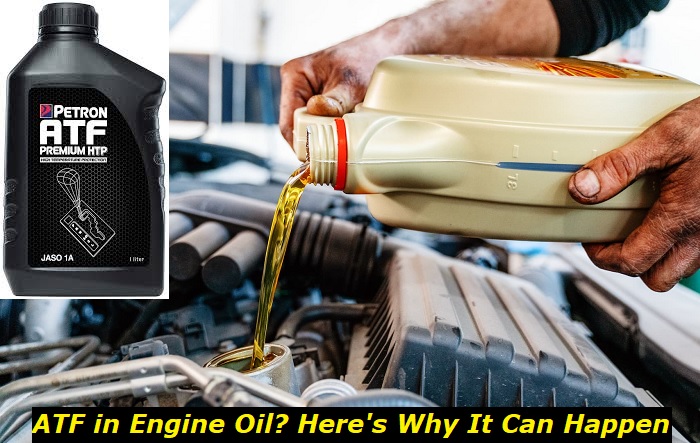If you know a thing or two about cars, you should be able to tell the difference between ATF and engine oil. It would be a real shock to find ATF in engine oil, especially if you didn't add it yourself. However, some drivers report seeing ATF mixed with engine oil. This article will delve into the possibility of this happening and what you should do should you discover ATF in engine oil.
Oil system cleaning highlights
- Level of urgency:medium
- Average mileage:not related to mileage
- Repair cost:$0 - $250
- DIY repair:possible
- Commonreasons:usingbadengine flushing methods
- If ignored:engine damage, poor lubrication
- How to solve:use proper oil andnormalintervals,don't flush the engine if it's notneeded

What is ATF?
ATF stands for Automatic transmission fluid. Note that it is not oil but fluid. This is because it's a product of numerous, usually more than 20, base oils and additives. ATF is a hydraulic fluid that helps the gears change smoothly. The transmission fluid is typically deep red and differs from manual gear oil, which is dark green.
ATF acts as a lubricant for the numerous moving parts inside the transmission. Because of its unique composition, it can operate in the very cold temperature of 40oC and as high as 300oC. The fluid ensures the seals neither harden nor prematurely age. To make it even more special, the ATF in your vehicle does not foam. Remember, the transmission has many fast-moving components, and any other liquid or fluid would form bubbles.
What is the difference between ATF and engine oil?
Automatic transmission fluid is manufactured using 70-80% base oil, and 20-30% is impurities that enhance its performance under diverse and extreme conditions. These impurities include acid-neutralizing compounds, anti-foaming compounds, and adverse temperature-deterring compounds. These compounds perform different specific functions in the transmission, which the engine oil can't accomplish.
The ATF levels and status can be monitored using the transmission dipstick. In most vehicles, the transmission or gearbox dipstick is easily accessible when you lift the hood. You will need specialized tools and expertise in some vehicles to access the transmission dipstick.
Every vehicle manufacturer has specifically indicated the exact ATF a vehicle should use. Using the wrong ATF can cause the transmission to malfunction, and in the worst-case scenario, you might end up replacing the whole transmission. Your car's ATF should be changed per the manufacturer's instructions. In most cases, the ATF should serve you between 60,000 and 100 000 miles.
On the other hand, engine oil protects the inside of an engine. Engine oil lubricates engine parts and prevents friction between the many moving parts. Engine oil has additives that help prevent sludge buildup, rust, and corrosion. Engine oil is amber in color and is monitored using an engine oil dipstick.
Like ATF, engine oil deteriorates with usage and should be replaced. Unlike ATF, engine oil should be replaced within 5,000 and 10,000 miles or per the manufacturer's specifications.
What happens when ATF mixes with engine oil?
ATF should not be added to the engine as its composition is different from that of the engine. Many DIYers added ATF to the engine to enhance its performance and durability. The engine oil of the older days was plain and had little or no additives, making the engine develop sludge and gunk. For this reason, some car enthusiasts added a little ATF to clean the engine.
Times have changed, and modern engine oil is loaded with additives that enhance its performance. Engine oil has cleansing compounds that remove the need to flush the engine with the ATF. If you intend to remove sludge in the engine, far better products are designed for this purpose. But as highlighted earlier, engine oil has cleaning detergents that make it unnecessary and even dangerous to use ATF in your engine.
Here are the reasons why you should not add ATF to engine oil
Adding a quart in the engine will not have immediate noticeable repercussions. In fact, many car gurus will tell you to let the engine run for some minutes before you drain the oil. But remember, modern engine oil is not the same as that made a decade ago. A large amount of ATF in the engine should be drained immediately, and you should not attempt to run the engine.
While some car enthusiasts will say ATF removes any sludge from the engine, this was the case years ago. Today, adding ATF to your engine will not improve anything at best. You may end up with a damaged engine in the long run.
1) ATF changes engine oil viscosity
The pistons in the engine come with oil rings which move about a lot. There are also other moving parts, such as the crankshaft and the tappets. The oil is specifically made to suit the needs of a particular engine. Changing the oil's viscosity by making it thicker or thinner ultimately affects how these moving engine components function. Reduced or increased consistency makes the engine parts work harder than designed, leading to lower engine performance.
2) Premature wear and tear of engine parts
ATF in the engine reduces the effectiveness of the engine oil. ATF is exposed to fewer combustion impurities than engine oil. As such, the ATF is made with reduced detergency. On the other hand, engine oil is formulated to lubricate, clean, and fight wear and tear over the period it is in the engine. Adding ATF dilutes the engine oil's effectiveness, and it has been observed that wear and tear of parts happen faster.
3) ATF might leak into the combustion chamber
The piston rings are designed to specifically work a given type of engine oil as stipulated by the car maker. The viscosity and the properties of the ATF are quite different from those found in the recommended engine oil. If a good amount of ATF finds its way into the sump, it will likely leak past the rings onto the combustion chamber. This would lead to a lot of smoke coming from the vehicle's exhaust.
Can ATF find its way in engine oil?
The transmission is separate from the engine. The engine produces torque, and the transmission converts it into mechanical power. The torque converter connects these two systems. It uses transmission fluid and links to the transmission via the turbine output shaft while the engine connects via the flex plate.
The transmission fluid in the torque converter moves at a very high speed through the stator, the impeller, and the turbine. The functioning of the torque converter has been separated from the engine, making it impossible for the transmission fluid to leak into the engine.
The torque converter and the transmission use transmission fluid. If the transmission was to leak, the ATF would not end up in the engine but instead in your parking lot. In some vehicles, leaking ATF might end up in the coolant system but not in the engine.
Some car owners have asked whether ATF can find its way into the engine oil. There is no way ATF can end up in the engine under normal vehicle running conditions. The most likely answer to this issue is if the ATF cap is easily accessible. When you visit the gas station, an over-enthusiastic attendant tops up the engine with ATF instead of engine oil.
The other possible reason is if your mechanic convinces you to add ATF to the engine to help remove sludge and gunk. As observed earlier, engine oil was not as effective as the one sold today. More additives in the oil help remove sludge from the engine over time.
What should you do when ATF mixes with engine oil?
If you accidentally fill up the engine with ATF rather than the recommended oil, have it flushed out immediately. When you drain the transmission after the ATF has reached the end of the road, dispose of such ATF appropriately and don't dump it in your engine. For some vehicles, you will need to seek the help of an expert if you accidentally add ATF to the engine.
Conclusion
The torque converter connects the engine and the transmission. The transmission fluid cannot mix with engine oil unless physically added, whether by accident or intentionally. If you find ATF in the engine oil, you should flush it immediately if the amount is substantial. If, on the other hand, the ATF is negligible, you can wait until the next service to drain all the contaminated oil. In this case, we assume the base oil in the ATF and engine oil to be similar.
About the authors
The CarAraC research team is composed of seasoned auto mechanics and automotive industry professionals, including individuals with advanced degrees and certifications in their field. Our team members boast prestigious credentials, reflecting their extensive knowledge and skills. These qualifications include: IMI: Institute of the Motor Industry, ASE-Certified Master Automobile Technicians; Coventry University, Graduate of MA in Automotive Journalism; Politecnico di Torino, Italy, MS Automotive Engineering; Ss. Cyril and Methodius University in Skopje, Mechanical University in Skopje; TOC Automotive College; DHA Suffa University, Department of Mechanical Engineering






Add comment